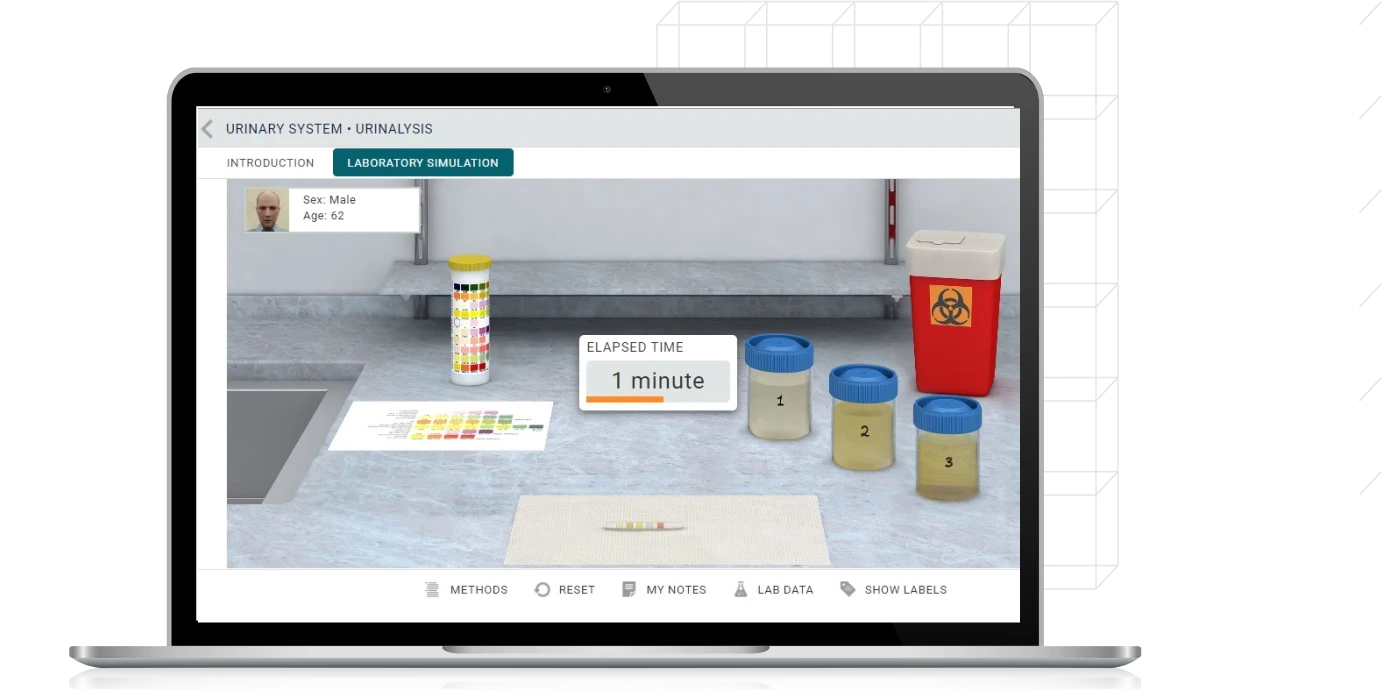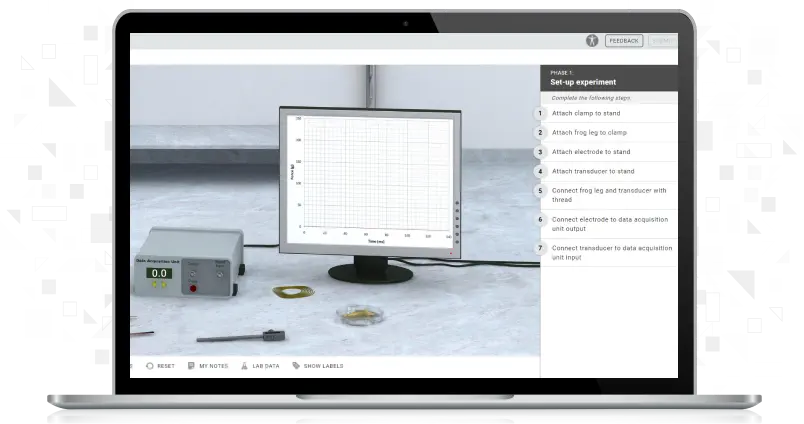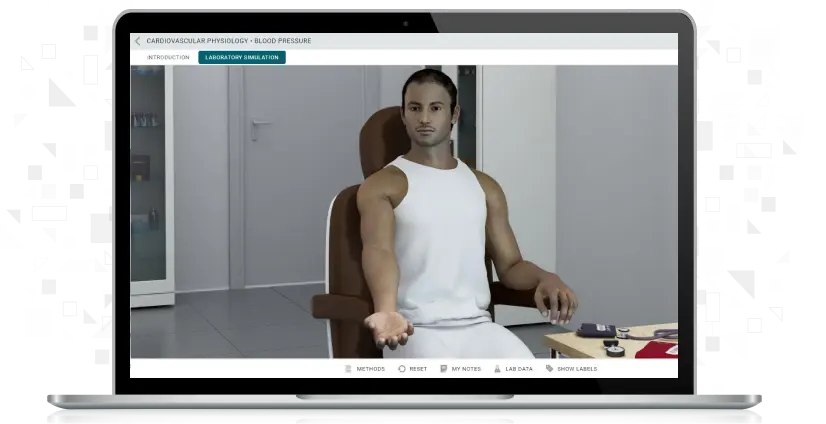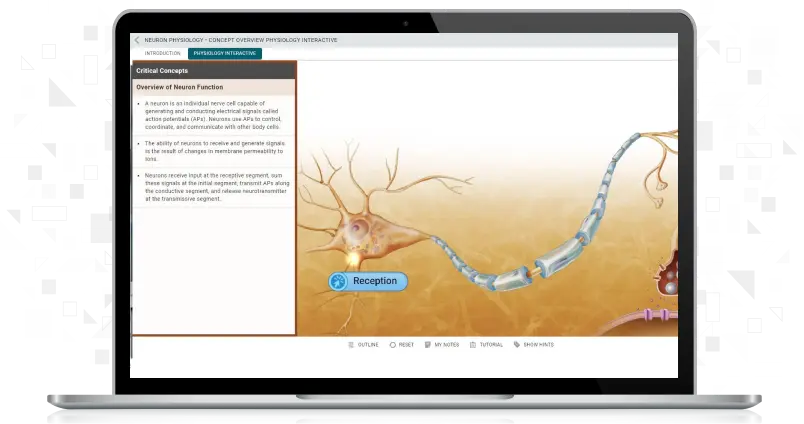My Account Details
Anatomy & Physiology
Through engaging, state-of-the-art laboratory simulations, you’ll discover the fascinating world of the human body—from cellular structure and organ systems to basic chemistry and challenging physiology concepts.

Featured Simulations for Anatomy & Physiology

Skeletal Muscle: Electrical Stimulation , Link will open in a new window
In this simulation, you will electrically stimulate a frog’s leg muscle using an electrode.

Cardiovascular Physiology: Blood Pressure , Link will open in a new window
In this simulation, you will measure blood pressure, determine the effect of body position on blood pressure, and determine the effect of exercise on blood pressure.

Neuron Physiology , Link will open in a new window
In this activity you will identify major structures of a typical multipolar neuron, view the factors involved in maintaining the resting membrane potential, and step through the major physiological events of the receptive, initial, conductive, and transmissive segments of a neuron.
See the growing list of Anatomy & Physiology simulations here:
1st Lab Tutorial
- Virtual Labs Tutorial
Applying the Scientific Method
- Pillbug Preference
Basic Chemistry
- Chemistry for Biology
- Density Cube
- Properties of Water
- Stoichiometry
- Titration Vinegar
Lab Safety
- Hand Washing Procedure
- Personal Safety
Metric Measurement
- Length
- Weight
- Volume
- Temperature
Chemical Composition of Cells
- Test for Starch
- Test for Sugars
- Digestion of Starch
- Emulsification of Lipids
- Test for Fat
- Test for Proteins
How Enzymes Function
- Effect of Temperature
- Enzyme Activity
- Effect of pH
- Effect of Concentration
Cellular Respiration
- Yeast Fermentation
- Measuring Energy Production in Plants Cell Structure
- Examining Plant & Animal Cells
Cell Structure
- Examining Plant & Animal Cells
Cell Membrane Transport
- Passive and Active Process of Membrane Transport - Concept Overview Physiology Interactive*
Cell Division
- Examining Meiosis
- Examining Mitosis
Control of Microbial Growth
- Effect Ultraviolet Light
- Effect of Antiseptics and Disinfectants
- Antimicrobic Sensitivity Testing (Kirby-Bauer Method)
Diffusion
- Effect of Concentration on the Rate of Diffusion in a Semisolid
- Effect of Density of Media on the Rate of Diffusion
- Effect of Molecular Weight on the Rate of Diffusion in Air
- Diffusion Across a Selectively Permeable Membrane
Osmosis
- Movement of Water Across a Selectively Permeable Membrane
- Tonicity in Red Blood Cells
- Tonicity in Elodea Cells
- Tonicity in Potato Strips
Microscopy
- Operation of a Brightfield Microscope
- Oil Immersion
- Epithelial Tissue Histology
- Connective Tissue Histology
- Muscle Tissue Histology
- Nervous Tissue Histology
- Euglena Wet Mount
- Pond Water Wet Mount
- Plant Cells
- Animal Cells
- Diversity of Microorganisms
Skeletal Muscle
- Effects of Stretch and Stimulus Frequency on Muscle Tension
- Isometric and Isotonic Contraction
- Shoulder and Elbow Movement Exercise
- Skeletal Muscle Contraction - Concept Overview Physiology Interactive*
- Electrical Stimulation
Electromyography
- Motor Unit Recruitment
- Time to Fatigue
Nervous System
- Resting Membrane Potential
- Compound Action Potential
- Temporal and Spatial Summation
- Demonstrate Monosynaptic Reflexes
- Neuron Physiology – Concept Overview Physiology Interactive*
Eye and Vision
- Eye Dissection
- Accommodation of the Lens
- Astigmatism Test
- Blind Spot Demonstration
- Color Vision Test
- Convergence Reflex Test
- Pupillary Reflex Test
- Visual Acuity Test
Endocrine System
- Endocrine System – Concept Overview Physiology Interactive*
- Influence of Thyroid Hormone on Temperature Regulation
- Effects of Blood Glucose Level
Blood
- Differential White Blood Cell Count
- Hematocrit
- Hemoglobin Content
- Blood Typing
Cardiovascular Physiology
- Abnormal Electrocardiograms
- Chemical Effects on the heart
- Frank-Starling Law of the Heart
- Refractory Period of the Heart
- Pulse Rate
- Blood Pressure
- Electrocardiography
- Heart Auscultation
- Cardiac Cycle- Concept Overview Physiology Interactive*
- Blood Pressure – Concept Overview Physiology Interactive*
Respiratory System
- Measuring Lung Volumes
- Oxygen-Hemoglobin Saturation Curve
- Mechanism of Breathing
- Pulmonary Function Tests
- Respiratory System – Concept Overview Physiology Interactive*
Lymphatic and Immune System
- Innate Immunity – Concept Overview Physiology Interactive*
- Adaptive Immunity – Concept Overview Physiology Interactive*
Urinary System
- Effects of Antidiuretic Hormone on Urine Formation
- Urinalysis
- Glomerular Filtration – Concept Overview Physiology Interactive*
- Tubular Reabsorption/Secretion- Concept Overview Physiology Interactive*
Digestive System
- Enzymes and Digestion
pH Balance
- Function of Buffers
- Antacids as Buffers
Human Genetics
- Chromosomal Inheritance During Meiosis
- Genetic Inheritance
Bacterial Genetics
- DNA Profiling
- PCR
- Bacterial Transformation
DNA Biology and Technology
- Isolation of DNA
- Gel Electrophoresis
- DNA/RNA Structure
- Rapid Diagnostic Testing
- Transcription, Translation, and Mutation
- Enzyme-Linked Immunosorbent Assay (ELISA) Testing
Mendelian Genetics
- Monohybrid Plant Cross
- Fruit Fly Characteristics
- Monohybrid Fruit Fly Cross
- Dihybrid Plant Cross
- Dihybrid Fruit Fly Cross
- X-Linked Fruit Fly Cross
Evidence of Evolution
- Molecular Evidence
- Fossils and Comparative Anatomy
Animal Dissection
- Fetal Pig I (Digestive, Respiratory, Endocrine Systems)
- Fetal Pig II (Circulatory, Urinary, Reproductive Systems)
* Concept-based overview interactive simulations that cover difficult physiology topics
